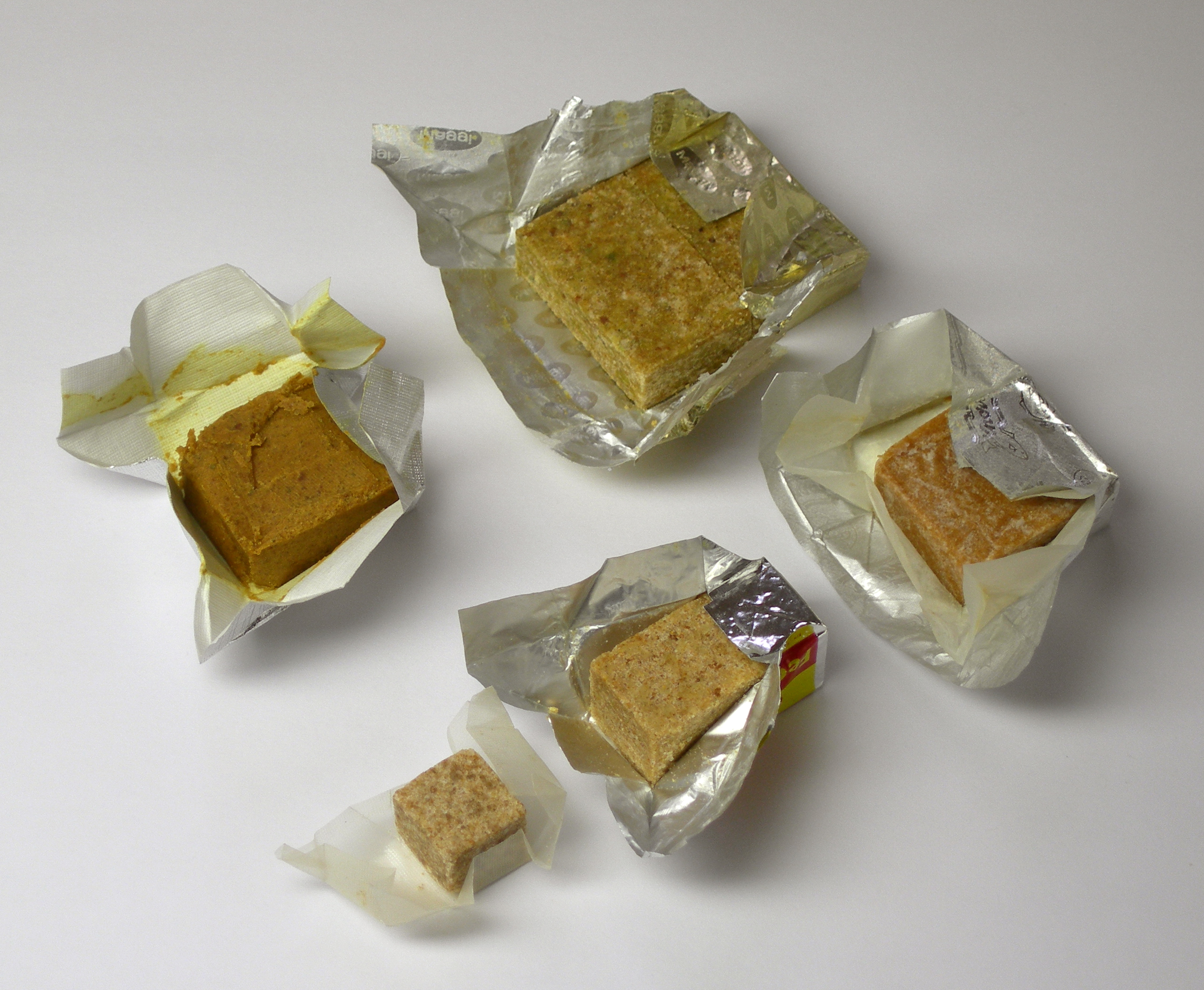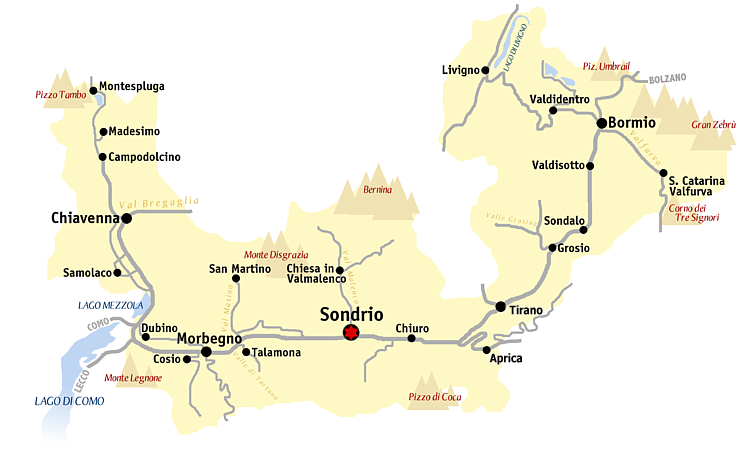|
Bündnerfleisch
Bündnerfleisch, also known as Bindenfleisch, Grisons Meat or Viande des Grisons, is an air-dried meat that is produced in the canton of Graubünden, Switzerland. Production The main ingredient is beef, taken from the animal’s upper thigh or shoulder, the fat and the sinews being removed. Before drying, the meat is treated with white wine and seasonings such as salt, onion and assorted herbs. The initial curing process, lasting 3–5 weeks, takes place in sealed containers stored at a temperature close to freezing point. The meat is regularly rearranged during this stage, in order to ensure that the salt and seasonings will be evenly distributed and absorbed. During a second drying phase the meat is then hung in free-flowing air at a temperature of between 9 and 14 °C. It is also periodically pressed in order to separate out residual moisture: from this pressing Bündnerfleisch acquires its characteristic rectangular shape. Traditionally Bündnerfleisch was not a smoked ... [...More Info...] [...Related Items...] OR: [Wikipedia] [Google] [Baidu] |
Hans-Rudolf Merz
Hans-Rudolf Merz (born 10 November 1942) is a Swiss politician who served as a Member of the Swiss Federal Council from 2004 to 2010. A member of the Free Democratic Party (FDP/PRD) until the foundation of FDP.The Liberals in 2009, he headed the Federal Department of Finance during his tenure as a Federal Councillor. Merz served as President of the Swiss Confederation in 2009. Biography Education Born in Herisau in the canton of Appenzell Ausserrhoden, he studied at Hochschule St. Gallen and graduated in 1971 with a DEA's degree. Merz was a Scout and visited the National Jamboree of Switzerland in July 2008. He is married and a father of three sons. Early political career From 1969 to 1974, he was party secretary of the Free Democratic Party (FDP/PRD) in St. Gallen. From 1974 to 1977 he worked as vice president for UBS's Wolfsberg formation centre in Ermatingen. Since then he has worked as a management consultant. In 1997 he was elected to the Swiss Council of States for ... [...More Info...] [...Related Items...] OR: [Wikipedia] [Google] [Baidu] |
Swiss Cuisine
Swiss cuisine is influenced by Austrian, French, German and Northern Italian cuisine, as well as by the history of Switzerland as a primarily agricultural country. As a result, many traditional Swiss dishes tend to be relatively plain and are made from basic ingredients, such as potatoes and Swiss cheese. The great cultural diversity within Switzerland is also reflected in the great number of regional or local specialties. Well-known Swiss dishes include raclette and fondue (molten cheese eaten with bread or potatoes), rösti (fried grated potatoes), muesli (an oatmeal breakfast dish) and Zürcher Geschnetzeltes (veal and mushrooms on a cream sauce). Food and dishes There are many regional dishes in Switzerland. One example is Zürcher Geschnetzeltes, thin strips of veal with mushrooms in a cream sauce typically served with rösti. Italian cuisine is popular in contemporary Switzerland, particularly pasta and pizza. Foods often associated with Switzerland include particular ... [...More Info...] [...Related Items...] OR: [Wikipedia] [Google] [Baidu] |
Bresaola
Bresaola ( , , , ) is air-dried, salted beef (but it can also be made of horse, venison and pork) that has been aged two or three months until it becomes hard and turns a dark red, almost purple color. It is made from top (inside) round, and it is lean and tender, with a sweet, musty smell. It originated in Valtellina, a valley in the Alps of northern Italy's Lombardy region. The word comes from the diminutive of Lombard ("braised"). Production A strict trimming process is essential to give the unique flavour. Legs of beef are thoroughly defatted and seasoned with a dry rub of coarse salt and spices, such as juniper berries, cinnamon and nutmeg. They are then left to cure for a few days. A drying period of between one and three months follows, depending on the weight of the particular bresaola. The meat loses up to 40% of its original weight during aging. In Valtellina, a similar process is applied to smaller pieces of meat. This produces a more strongly flavoured produc ... [...More Info...] [...Related Items...] OR: [Wikipedia] [Google] [Baidu] |
Dried Meat
Dried meat is a feature of many cuisines around the world. Examples include: *Kulen Slanina Pečenica *Aliya, sun-dried meat from Kenya * Bakkwa or rougan, Chinese salty-sweet dried meat sheets. * Biltong, a cured meat that originated in Southern Africa. * ''Bògoǫ'', a dried and smoked meat, often caribou, of the Dené people of northern Canada. * Borts, air-dried strips of horse or cow meat used as traveling food or to last the winter in Mongolia. Often ground into powder and mixed with water to create soup. * Bresaola, air-dried salted beef originally from the Valtellina valley in northern Italy. * Brési, made in the canton of Jura and in Jura Bernois in Switzerland and in the department of Doubs in France. * Bündnerfleisch, air-dried meat from Kanton Graubünden in Switzerland. * Carne-de-sol, sun-dried salt beef from Brazil. * Carne seca, air-dried meat from Mexico. * Cecina, lightly smoked, dried, and salted meat from northwestern Spain (Asturias, León, Cantabr ... [...More Info...] [...Related Items...] OR: [Wikipedia] [Google] [Baidu] |
Beef
Beef is the culinary name for meat from cattle (''Bos taurus''). In prehistoric times, humankind hunted aurochs and later domesticated them. Since that time, numerous breeds of cattle have been bred specifically for the quality or quantity of their meat. Today, beef is the third most widely consumed meat in the world, after pork and poultry. As of 2018, the United States, Brazil, and China were the largest producers of beef. Beef can be prepared in various ways; cuts are often used for steak, which can be cooked to varying degrees of doneness, while trimmings are often ground or minced, as found in most hamburgers. Beef contains protein, iron, and vitamin B12. Along with other kinds of red meat, high consumption is associated with an increased risk of colorectal cancer and coronary heart disease, especially when processed. Beef has a high environmental impact, being a primary driver of deforestation with the highest greenhouse gas emissions of any agricultural product ... [...More Info...] [...Related Items...] OR: [Wikipedia] [Google] [Baidu] |
Pastrami
Pastrami (Romanian: '' pastramă'') is a food originating from Romania usually made from beef brisket, lamb, pork, chicken sometimes from turkey. The raw meat is brined, partially dried, seasoned with herbs and spices, then smoked and steamed. Like corned beef, pastrami was originally created as a way to preserve meat before the invention of refrigeration. One of the iconic meats of Romanian cuisine as well as American Jewish cuisine and the New York City cuisine, hot pastrami is typically served at delicatessen restaurants on sandwiches such as the pastrami on rye. Etymology and origin The name pastrami comes from Romanian ''pastramă'', which is related to the Turkish '' pastırma''. It is probably derived from the Turkish verb '' bastırmak'' meaning "to press". However, it could also be from the Romanian '' a păstra'' meaning "to keep, preserve". Both of these etymologies are plausible, but mutually exclusive. Wind-dried beef had been made in Anatolia for centuries, and ... [...More Info...] [...Related Items...] OR: [Wikipedia] [Google] [Baidu] |
List Of Dried Foods
This is a list of dried foods. Food drying is a method of food preservation that works by removing water from the food, which inhibits the growth of bacteria and has been practiced worldwide since ancient times to preserve food. Where or when dehydration as a food preservation technique was invented has been lost to time, but the earliest known practice of food drying is 12,000 BC by inhabitants of the modern Middle East and Asia."Historical Origins of Food Preservation". Accessed June 2011. Dried foods Processed foods B  ...
...
[...More Info...] [...Related Items...] OR: [Wikipedia] [Google] [Baidu] |
Bresaola
Bresaola ( , , , ) is air-dried, salted beef (but it can also be made of horse, venison and pork) that has been aged two or three months until it becomes hard and turns a dark red, almost purple color. It is made from top (inside) round, and it is lean and tender, with a sweet, musty smell. It originated in Valtellina, a valley in the Alps of northern Italy's Lombardy region. The word comes from the diminutive of Lombard ("braised"). Production A strict trimming process is essential to give the unique flavour. Legs of beef are thoroughly defatted and seasoned with a dry rub of coarse salt and spices, such as juniper berries, cinnamon and nutmeg. They are then left to cure for a few days. A drying period of between one and three months follows, depending on the weight of the particular bresaola. The meat loses up to 40% of its original weight during aging. In Valtellina, a similar process is applied to smaller pieces of meat. This produces a more strongly flavoured produc ... [...More Info...] [...Related Items...] OR: [Wikipedia] [Google] [Baidu] |
Pastirma
Pastirma or basturma, also called pastarma, pastourma,, basdirma, or basterma, is a highly seasoned, air-dried cured beef that is found in the cuisines of Turkey, Armenia, Azerbaijan, Bulgaria, Egypt, and Greece, Iraq and North Macedonia. Etymology and history ''Pastırma'' is mentioned in Mahmud of Kashgars ''Diwan Lughat al-Turk'' and Evliya Çelebis '' Seyahatname''. According to Turkish scholar Biron Kiliç, the term ''pastirma'' is derived from the Turkic noun ''bastırma'', which means "pressing". Some say ''basturma'' originated in ancient Armenian cuisine, where it was known as ''aboukh. ''The Oxford Encyclopedia of Food and Drink'' writes that ''pastırma'' is the word the Ottomans used for a type of Byzantine cured beef that was called ''paston'' (παστόν). According to Johannes Koder, an expert in Byzantine studies, ''paston'' could mean either salted meat or salted fish, while ''akropaston'' (ἀκρόπαστον) means salted meat. Andrew Dalby gives the def ... [...More Info...] [...Related Items...] OR: [Wikipedia] [Google] [Baidu] |
Jerky (food)
Jerky is lean trimmed meat cut into strips and dried (dehydrated) to prevent Food spoilage, spoilage. Normally, this drying includes the addition of salt to prevent bacteria growth before the meat has finished the dehydrating process. The word "jerky" derives from the Quechua languages, Quechua word ''wikt:ch'arki#Quechua, ch'arki'' which means "dried, salted meat".Teofilo Laime Ajacopa, Diccionario Bilingüe Iskay simipi yuyayk'ancha, La Paz, 2007 (Quechua-Spanish dictionary) All that is needed to produce basic "jerky" is a low-temperature drying method, and salt to inhibit bacterial growth. Modern manufactured jerky is often marinated, prepared with a seasoned spice rub or liquid, or Smoking (cooking), smoked with low heat (usually under 70 °C/160 °F). Store-bought jerky commonly includes sweeteners such as brown sugar. Jerky is ready-to-eat, needs no additional preparation and can be stored for months without refrigeration. To ensure maximum shelf-life, a proper ... [...More Info...] [...Related Items...] OR: [Wikipedia] [Google] [Baidu] |
Federal Assembly Of Switzerland
The Federal Assembly (german: Bundesversammlung, french: Assemblée fédérale, it, Assemblea federale, rm, Assamblea federala), also known as the Swiss parliament (''Parlament'', ''Parlement'', ''Parlamento''), is Switzerland's federal legislature. It meets in Bern in the Federal Palace. The Federal Assembly is bicameral, being composed of the 200-seat National Council and the 46-seat Council of States. The houses have identical powers. Members of both houses represent the cantons, but, whereas seats in the National Council are distributed in proportion to population, each canton has two seats in the Council of States, except the six 'half-cantons', which have one seat each. Both are elected in full once every four years, with the last election being held in 2019. The Federal Assembly possesses the federal government's legislative power, along with the separate constitutional right of citizen's initiative. For a law to pass, it must be passed by both houses. The two ho ... [...More Info...] [...Related Items...] OR: [Wikipedia] [Google] [Baidu] |
Valtellina
Valtellina or the Valtelline (occasionally spelled as two words in English: Val Telline; rm, Vuclina (); lmo, Valtelina or ; german: Veltlin; it, Valtellina) is a valley in the Lombardy region of northern Italy, bordering Switzerland. Today it is known for its ski center, hot spring spas, bresaola, cheeses (in particular Bitto, named after the river Bitto) and wines. In past centuries it was a key alpine pass between northern Italy and Germany and control of the Valtellina was much sought after, particularly during the Thirty Years' War as it was an important part of the Spanish Road. Geography The most important comune of the valley is Sondrio; the others major centers are Aprica, Morbegno, Tirano, Bormio and Livigno. Although Livigno is on the northern side of the alpine watershed, it is considered part of Valtellina as it falls within the province of Sondrio. History Antiquity and the middle ages The region was conquered in 16 BC by the Romans. By the 5th century i ... [...More Info...] [...Related Items...] OR: [Wikipedia] [Google] [Baidu] |






.jpg)
